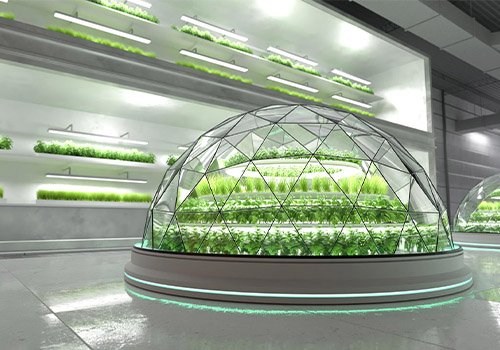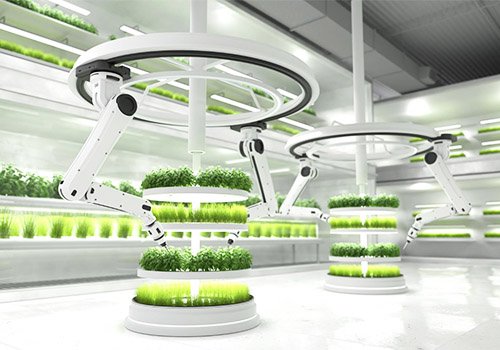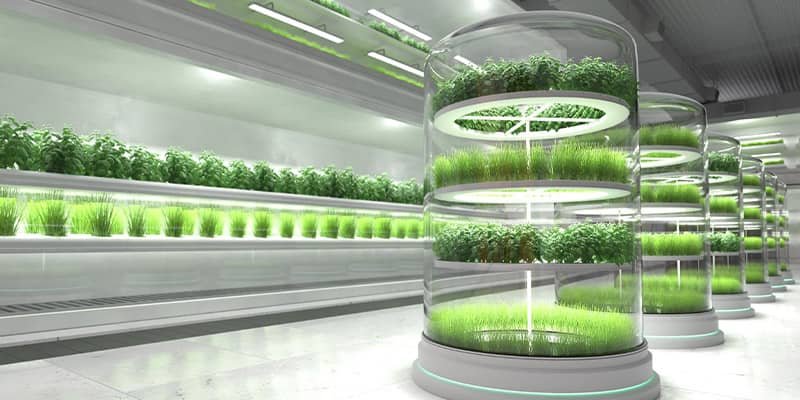Innovations in hydroponics technologies have been evolving. Some exciting technologies have emerged to streamline the indoor cultivation process. Hydroponics, a modern revolutionary soilless agricultural system is being expanded because of the use of new-age innovations.
Hydroponic growers grow plants using water-based nutrient solutions. Regarding soilless farming, it’s gaining fame around the world. However, new technologies, especially after the pandemic, are shaping the future of hydroponic farming. For instance, the addition of Artificial Intelligence (AI) is one of the most significant developments in this sector.
Hydroponic growers are now equipped with AI-powered sensors and monitoring systems that can help them to collect and analyze massive amounts of real-time data about temperature, humidity, nutrient levels, and pH levels. So, this blog will explore all the recent innovations in hydroponics technologies that are reshaping the way we grow food.
The Evolution in Hydroponics

In the late 1920s, Dr. William F. Gerick experimented with nutrients in practical and commercial crops growing outside. He is the one who coined the term “Hydroponic”. It comes from the Greek word where ‘Hydro’ means water and ‘Ponos’ means water working. However, it’s observed that hydroponic methods have been used since long ago. People from the 6th century utilized the Euphrates River as the source of their irrigation.
The first proof of using the hydroponic method was observed in the 10th century when Aztec people (known for agriculture, land, art, and architecture) used a floating garden in a nearby lake. However, the ancient technologies used in hydroponics can’t be seen through. Now the latest technology in hydroponic systems has been changed more than ever before. That’s why the importance and use of hydroponics is increasing day by day.
Some advanced technologies and methods that have recently been used in hydroponic systems have transformed the working process of hydroponic growers. Here is a list of the latest technologies used in hydroponic systems:
- Automation and loT
- Artificial Intelligence
- LED Lighting Innovations
- Hydroponic Robotics
- Smart Sensors
Key Technologies in Hydroponics
Now the question is what technology is used in hydroponics? The revolution of AI and automation has already started its mission of changing the world of indoor cultivation. Hydroponic farmers are now focusing more on data critical and automation development rather than working on laborious mundane tasks.
As automation progresses, growers can easily manage and maintain growing conditions, seeding, harvesting, and packaging. This ultimately gives laborers and growers a huge amount of time to do tasks like documentation and varieties of growing operations. They can also learn and observe what is happening on the farm.
So, this is certain that the innovations in hydroponics technologies are shaping the grower’s cultivation process. Now, let’s take a closer look at some of the mainstream agricultural techniques that are used by hydroponic growers.
Nutrient Film Technique (NFT)
NFT (Nutrient Film Technique), also called Nutrient Delivery System, is an active hydroponic system where growers use a pump to move a thin layer of nutrient solutions through small channels. Thus, the plant’s roots can dip into them and absorb nutrients. This nutrient is equivalent to fertilizers and chemicals used in traditional agriculture.
Besides, NFT is a sustainable system as it protects the conservation of water compared to traditional farming methods. Also, unlike other methods, it makes sure a sufficient supply of water, nutrients, and oxygen to the plant roots. In a hydroponics system, farmers can grow lettuce, herbs, and other leafy greens. However, several hydroponics supplies are required for growers to be successful.
Here are a few components of Nutrient Delivery Systems (NFT):
- Water Pump: It transports nutrient solutions from the reservoir to the grow trays via a water pump.
- Air Pump: This device oxygenates and aerates nutrient solutions.
- Growing Channels: It takes less water to feed your plants properly. Growing channels are up to 15 m long and have a slope of between 1% and 3%.
- Nutrient Solution: Nitrogen, phosphorus, and potassium are the three most important elements.
Controlled Environment Agriculture (CEA)
To be a successful hydroponic grower, you need an optimal environment. Controlled Environment Agriculture (CEA) is a technique used in indoor greenhouse gardening. In this process, growers create an optimal growing environment for the indoor crops, and as the term suggests this is done by controlling some of important environmental factors. The blessing of innovation in hydroponics made it possible to control factors like indoor temperature, humidity, light, and carbon-di-oxide (CO2) levels. Besides, growers use the grow tents facility to achieve an ideal environment for their plants. And it also offers hydroponic growers with fresh environment compared to outdoor farming. CEA doesn’t only provide the facility with controlling environmental factors but also gives the hydroponic growers to grow crops year-round.
Automation and loT
The latest technologies like automation and the internet have changed the way we work, live, and make things in our life. Hydroponic isn’t any different from it. Growers are continuously utilizing new innovations in hydroponics technologies to improve and smoothen their cultivation process. However, automation and loT (Internet of Things) offer devices, sensors, and data analytics to accurately monitor and manage the hydroponics system remotely. These advanced technological facilities are helping farmers to create a more productive hydroponic growing system.
For instance, nowadays, hydroponic growers can benefit from carefully placed IoT sensors that monitor water quality, nutrient concentration, electrical conductivity (EC), and pH levels.
Besides, these sensors collect real-time data about mineral nutrient levels and send them to the central hub so that crofters can get valuable insights into their indoor farms.
Vertical Farming
In simple words, vertical farming is one of the key technologies to grow crops in vertically stacked layers instead of following traditional horizontal agriculture. For instance, skyscrapers, and shipping containers. It is used in most soilless farming methods like hydroponics, aquaponics, and aeroponics. However, this type of farming is intended to use the unused spaces of urban areas. Because of industrialization and urbanization, the cultivation space is decreasing on a regular basis. Here vertical farming method helps the hydroponic growers to make the most out of limited areas.
Here are some of the core benefits of Vertical farming:
- Climate control
- Year-round production
- Utilizing unused urban spaces
- Higher yields due to control over environmental factors
Artificial Intelligence (AI)
One of the most revolutionary innovations in hydroponics technologies is Artificial Intelligence (AI). Now, hydroponic cultivators are using AI to grow healthier crops, control applications of pesticides, and monitor soil and growing conditions.
With AI, growers can analyze farmer data and improve food supply chain management. Before AI, it was quite challenging for the crofters to pick the ideal time for seed plantation which became easy after the arrival of artificial intelligence.
Now farmers can learn data about weather forecasts and choose optimum seeds. In short, this mind-blowing technology reshapes the agricultural process and gives benefits to farmers to grow more crops with fewer resources.
Latest Technological Impacts
We have so far discussed the key technologies that are being utilized by hydroponics growers. Now, let’s explore the latest innovations in hydroponics technologies that are reshaping the future of the indoor cultivation process.
Smart Sensors
Hydroponic growers are now equipped with smart sensors. The smart monitoring systems are made with 3 types of sensors.
1. Master Node: This allows gardeners to control the pump. Also, it permits farmers to monitor the quality of the water.
2. Environment Sensing Slave Node: Supervise the current conditions in the greenhouse/indoor garden and send the data to the main node.
3. Security Node Monitor Activity: It provides data about water quality, hydroponic garden temperature, and humidity.
Besides, to perfectly construct a hydroponic system, hydroponics growers also use monitoring systems like conductivity sensors and pH sensors.
Nutrient Management Software
Another latest technology for the hydroponics system is nutrient management software. Growers are using it for calculating precise nutrient formulations based on plant needs, reducing waste, and optimizing growth.
Here is a list of nutrient management software for growing healthy plants:
1. Grow Advisers: Made for soilless cultivation. It creates a nutrient recipe for indoor plants based on the plant type and growth stage. Also, it analyzes data to fine-tune nutrient solutions.
2. Hydro Buddy: It also helps hydroponic growers to create customized nutrient solutions based on the resources. It provides detailed information about chemical compositions.
3. Crop Steering Software: It provides a greenhouse control system based on environmental factors like light, temperature, humidity, and substrate moisture, along with plant growth data.
There are some other innovative technologies available that hydroponic growers can implement for the betterment of their farming efforts.
LED Lighting Innovations
LED lights are the substitute for natural sunlight that houseplants need for photosynthesis. LEDs grow lights are the least radiant and energy efficient, therefore growers can use them to control the inside temperature of the garden with proper heat and light exposure.
Besides, LED lights emit specific wavelengths for different growth stages. As a result, the amount of light spectrum needed for a plant’s vegetative, flowering, and fruiting stages is fulfilled by this extraordinary hydroponic innovation. Eventually, hydroponic growers get the highest yield from their indoor cultivation.
Hydroponic Robotics

The addition of robotic technology in hydroponics farming is another great advantage for growers. Hydroponics robots are farming helpers that work alongside plants. These robots are capable of planting seeds, picking crops, and taking care of plants. They can reduce the labor cost and they will ensure that your plants grow well.
Hydroponic robots use smart technology, for example, computer vision, and machine learning, and are able to handle the job used to be done only by cultivators. So, this innovation in hydroponics technology is shaping the future of indoor farming in a way where humans and robots will create a better, sustainable, and eco-friendly earth by working together.
Benefits and Impact of Innovations in Hydroponics Technologies
It’s entirely evident that technological innovation and development have given immense benefits to plant growers and agriculturalists. Because of this latest technology in hydroponics, farmers are now able to save time, save energy, and achieve higher yields, and the most important thing is that it’s not inflicting eco-grief on the eco-conscious minds of green panthers. However, here are some common benefits of utilizing present-day technologies in hydroponic cultivation.
- Resources Efficiency
- Year-round Production
- Crop Quality and Yield
- Reduced Chemical Dependency
Resources Efficiency
Urbanization has grown parallelly with industrialization. That is why farmland has been decreasing drastically. But thanks to hydroponic vertical farming that can work within a limited space and create a productive and sustainable indoor garden.
Year-Round Production
The latest technologies in hydroponics have been a blessing for the hydroponic farmers. They can predict the weather condition, monitor plant health, and create an optimal environment for the grow room that ultimately helps them to produce almost all types of fruits, vegetables, and medicine plants around the year.
Crop Quality and Yield
In a hydroponic system, technology has enabled growers to understand and measure the amount of nutrients a plant needs. As a result, the quality of the produced crop has increased. Besides, Controlled Environment Agriculture (CEA) ensures a perfect environment to grow healthy which results in higher yields.
Reduced Chemical Dependency
Nutrient Management Software is another technology in a hydroponic system that makes it possible to calculate the precise amount of required nutrients. For that reason, dependency on chemicals, for instance, fertilizers, and pesticides have reduced.
Challenges and Future Prospects
Everything in this world has two sides, one brighter and another a barrier. So, we’ve talked about the brighter sides of using the latest technologies and innovations in hydroponics systems. Now, there are some barriers, and these are especially experienced by small growers who have limited resources and knowledge.
Initial Investment
In order to get the hydroponic farm up and running, amateur growers need budget planning. An Initial set-up cost may vary from around $10000 to $120000 depending on the plan and resources.
To set up a hydroponic system, the grower should make a financial plan considering the following equipment and resources:
- Lands and Building
- Hydroponic Supplies (E.g., Water Pump, Air Pump)
- Refrigeration
- Storage Facilities
- Security Systems
- Environmental Protection
- Utilities and Licensed
Technical Knowledge
Technical knowledge of hydroponic systems and indoor plantations is obligatory for growers and staff. Hydroponic farmers need to acquire knowledge of the latest technology integration, crop management, and system maintenance to perform well and produce better crops.
However, small investors and growers might not have the resources to have expert staff. If this challenge arises, they should try to minimize their set-up initially and increase technical knowledge resources. Furthermore, small hydroponic growers should also learn about the latest technologies to streamline the hydroponics farming process.
Frequently Asked Questions (FAQs)
What are the innovations in hydroponics technologies?
Artificial intelligence for predicting data (weather), smart sensors for monitoring water quality, humidity, and temperature, and hydroponics robotics for repetitive and mundane tasks are some of the latest innovations of hydroponic technologies.
What are the key techniques and technologies used in hydroponics systems?
NFT (Nutrient Film Technique), Ebb and Flow, Vertical Farming, and CEA (Controlled Environment Agriculture), are some techniques hydroponic growers use to optimize indoor gardening.
Does Hydroponic have a future?
Certainly. Hydroponic is already a very popular soilless cultivation system. It is sustainable and doesn’t need vast amounts of land to produce crops. As urbanization is increasing vehemently, it is quite certain that hydroponic along with other similar types of farming will experience more practices and success in the future.
Conclusion
The innovations in hydroponics technologies are a blessing for the hydroponic growers. Unlike traditional soil-based firming, hydroponic systems can work within a limited space. Besides, the latest innovations and technologies like vertical farming, artificial intelligence, NFT, CEA, Hydroponics Robotics, and smart sensors have streamlined the operation of the hydroponics growing method. Besides, robust technologies and software are still developing to reshape the future of indoor gardening and industrial cultivation, which will probably outperform traditional cultivation in the near future.
